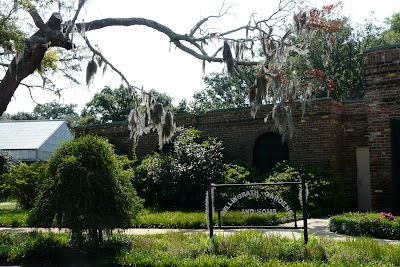What a lucky surprise, we found the neatest off the beaten path little town of St. Francisville, LA. It is the state’s second oldest incorporated town and maintains a quiet dignity and old-fashioned character. Established in 1785 atop a bluff above the port, it prospered during the 19th century, as shipping captains and industrialists built grand homes and plantations.


 The historic district preserves many of the most beautiful homes and churches. There are all sorts of Victorian buildings on streets lined with magnolias, crepe myrtles, and other flowering trees. Spanish Moss hangs from many of the trees. There were many inns and B & Bs.
The historic district preserves many of the most beautiful homes and churches. There are all sorts of Victorian buildings on streets lined with magnolias, crepe myrtles, and other flowering trees. Spanish Moss hangs from many of the trees. There were many inns and B & Bs.
 We toured two of their most prominent attractions. Our first stop was the Audubon State Historic Site, home of Oakley Plantation. This plantation was established in 1806 by the Pirrie family in the area that was part of Spanish West Florida. It wasn’t until after the West Florida Rebellion of 1810 that it became part of the U.S.
We toured two of their most prominent attractions. Our first stop was the Audubon State Historic Site, home of Oakley Plantation. This plantation was established in 1806 by the Pirrie family in the area that was part of Spanish West Florida. It wasn’t until after the West Florida Rebellion of 1810 that it became part of the U.S.
 Oakley Plantation was a very large and wealthy cotton plantation. At its peak it was 3,200 acres and around 230 slaves worked here. We were greeted by a domesticated turkey named Gus who was more than happy to show us his feathers and was thrilled when we took his picture. He has been here for about 2 years after someone dropped him off.
Oakley Plantation was a very large and wealthy cotton plantation. At its peak it was 3,200 acres and around 230 slaves worked here. We were greeted by a domesticated turkey named Gus who was more than happy to show us his feathers and was thrilled when we took his picture. He has been here for about 2 years after someone dropped him off. It has a formal English garden which in its center housed the family’s in-ground cistern. The kitchen is behind the house which has in it the original brick hearths and they have been in working order for 200 years.

Our next stop was Rosedown Plantation State Historic Site.
 At the time that Rosedown construction was started, Daniel Turnbull was one of the richest men in the nation. He and his wife Martha built this immense cotton plantation (3,455 acres) and filled the 1834 neoclassical manor house with museum quality antiques from the North and from Europe. It is much more ornate than the Oakley Plantation. During the peak years of cotton production, as many as 450 slaves worked here.
At the time that Rosedown construction was started, Daniel Turnbull was one of the richest men in the nation. He and his wife Martha built this immense cotton plantation (3,455 acres) and filled the 1834 neoclassical manor house with museum quality antiques from the North and from Europe. It is much more ornate than the Oakley Plantation. During the peak years of cotton production, as many as 450 slaves worked here.

The contraption hanging over the dining room table is called a "shoo-fly". It was one of the most sought after slave jobs. Instead of working in the hot cotton fields, the slave would stand in the corner of the room and pull the rope that moved the shoo-fly back and forth while the family was dining to keep the flies off them and the food.

The formal gardens were begun around the same time as the house. The gardens were the province of Martha Turnbull throughout her entire life. They grew out from the house over a span of several years, covering approximately 28 acres.

Currently the main house, historic gardens and 13 historic buildings and 371 remaining acres are preserved as a state historic site by the Office of Louisiana State Parks.


 We had a very enjoyable day touring these two plantations and the homes on them. Although it was very hot and humid, the homes renovations included air conditioning! Yay!
We had a very enjoyable day touring these two plantations and the homes on them. Although it was very hot and humid, the homes renovations included air conditioning! Yay!
 We enjoyed a full day at Silver Springs where they have glass-bottom boats, jeep tours, river cruises, wild animal shows and exhibits.
We enjoyed a full day at Silver Springs where they have glass-bottom boats, jeep tours, river cruises, wild animal shows and exhibits. 



























 Our campground surrounds a huge stocked fishing pond.
Our campground surrounds a huge stocked fishing pond.































